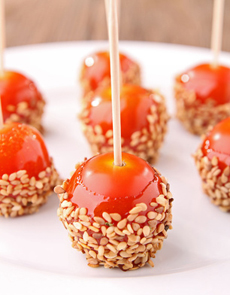Red Candy Apples History & Recipe
|
|
Yesterday we published a recipe for caramel apples, also known as toffee apples.
Today we present candy apples: the same concept, but with a hard, crackly red candy coating instead of the softer caramel. The practice of coating fruit in sugar syrup dates back to ancient times. In addition to tasting good, honey and sugar were used as preserving agents to keep fruit from rotting. > So are more candy apple recipes. > The year’s 19 apple holidays. > The history of candy apples and caramel apples. > The history of Halloween. Who Invented Candy Apples According to FoodTimeline.org, food historians generally agree that caramel apples (toffee apples) probably date to the late 19th century. Both toffee and caramel candies (the difference) can be traced to the early decades of the 18th century. Inexpensive toffee and caramels became available by the end of the 19th century. Culinary evidence confirms soft, chewy caramel coating from that time. Red cinnamon candy apples came later. And, while long associated with Halloween, they were originally Christmas fare, not a Halloween confection. According to articles in the Newark Evening News in 1948 and 1964, the red candy apple was invented in 1908 by William W. Kolb, a local confectioner. Experimenting with red cinnamon candies for Christmas, he dipped apples into the mixture, and the modern candy apple was born. The tasty treat was soon being sold at the Jersey Shore, the circus, and then in candy shops nationwide. Red candy apples were once a popular trick-or-treat booty. Beginning in the 1960s, they became less popular when news reports scared the public into thinking that sociopaths were inserting razor blades or needles into the apples. (This was later exposed as a hoax.) As a precaution, newscasters advised parents that their children should accept only factory-sealed, packaged candy. Candy bar companies jumped on the opportunity to advertise their packaged candies as the “safe alternative” for Halloween treats. Parents would sort through the candies kids brought back to discard any unwrapped, loose treats (and they still do). Caramel apples debuted many years later. |
|
|
In the 1950s, a Kraft Foods employee, Dan Walker, melted Kraft caramels and dipped apples on a stick, following the lead of candy apples. Walker said that he created the treat while experimenting with excess caramels from Halloween sales. While caramel apples were dipped by hand for the first decade or so, Vito Raimondi of Chicago made and patented the first automated caramel apple machine in 1960 [source]. National Candy Apple Day and National Caramel Apple Day are both celebrated on October 31st, Halloween. You can whip up a batch in just 20 minutes. Ingredients Preparation 1. Line a baking sheet with aluminum foil. Spray the foil with nonstick cooking spray. 2. Wash the apples carefully and remove any stems. Stick the apples in boiling water* for 10 seconds, then remove and dry thoroughly—moisture will prohibit the coating from adhering properly. You can do this step first; towel dry the apples, then let them air-dry for an hour or more. 3. Stick the skewers firmly in the stem ends. 4. Combine the water, corn syrup, and sugar in a medium saucepan over medium-high heat. Stir until the sugar dissolves; then continue to cook, without stirring, until mixture reaches 250° degrees on a candy thermometer. Occasionally wash down the sides of the pan with a wet pastry brush to prevent crystallization. 5. Once the candy thermometer reaches 250°F, add the cinnamon candies or cinnamon oil and stir briefly to incorporate. Continue to cook, washing down the sides, until the thermometer reaches 285°F. 6. Remove the pan from the heat and stir the candy coating until it is smooth. Hold an apple by the skewer and dip it into the candy, tilting the pan at an angle and rotating the apple to cover it completely with an even layer. Remove the apple and twirl over wax paper to remove the excess, then set it on the prepared baking sheet. Repeat with remaining apples. 7. Allow the apples to cool. Candy apples are best enjoyed within 24 hours when the candy coating will be the most crackly. Over time, ambient moisture and humidity cause the coating to soften. TIP: If you have leftover candy syrup, there’s no need to waste it. Spoon it into rounds on a wax paper- or parchment-covered cookie sheet until it hardens into red cinnamon hard candy. *Boiling water removes any wax from the apples and helps the coating to adhere. Alternatively, you can soak them for a few minutes in hot tap water with a dash of cider vinegar, then remove and polish dry with a soft cloth. You can also purchase Veggie Wash, a spray solution that removes the wax from fruits and vegetables. CHECK OUT WHAT’S HAPPENING ON OUR HOME PAGE, THENIBBLE.COM. |
||




